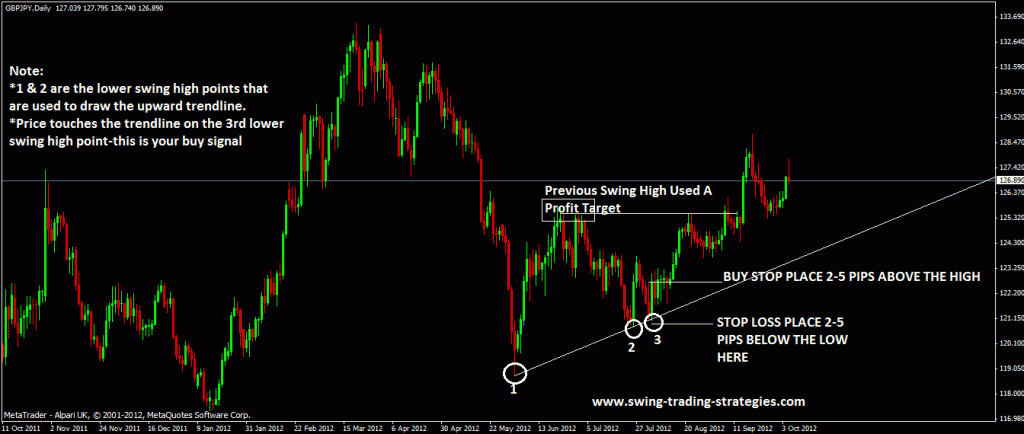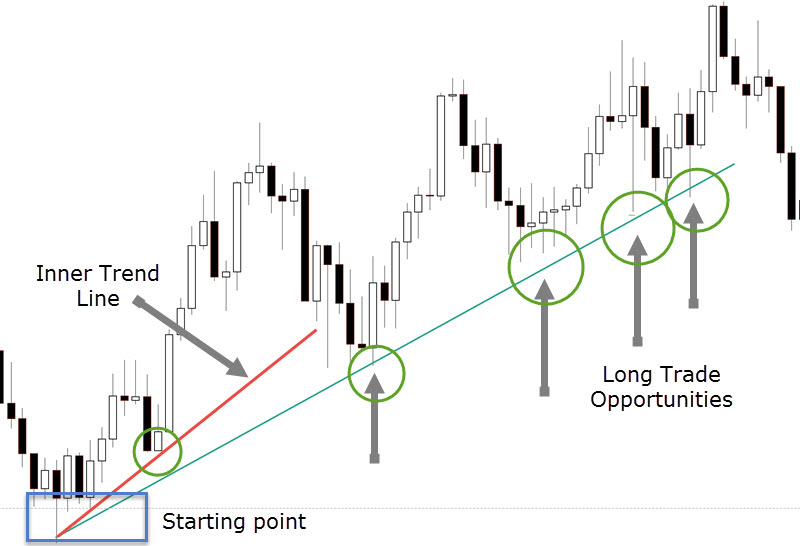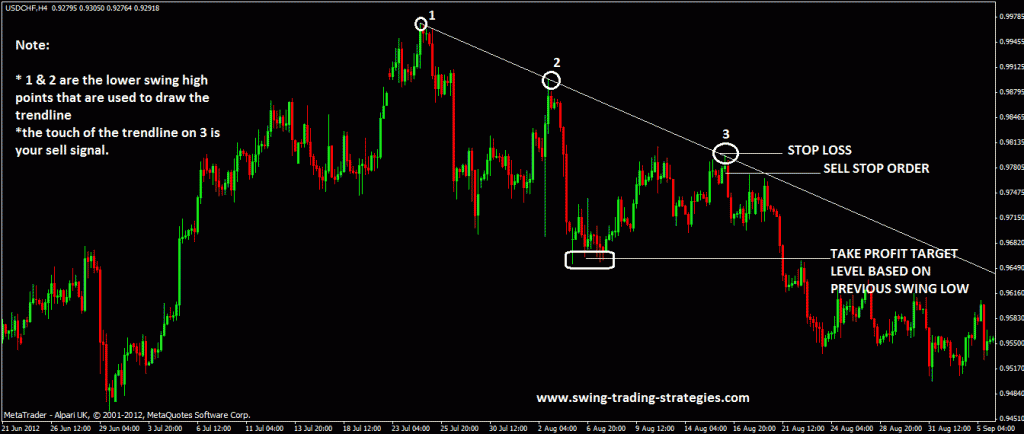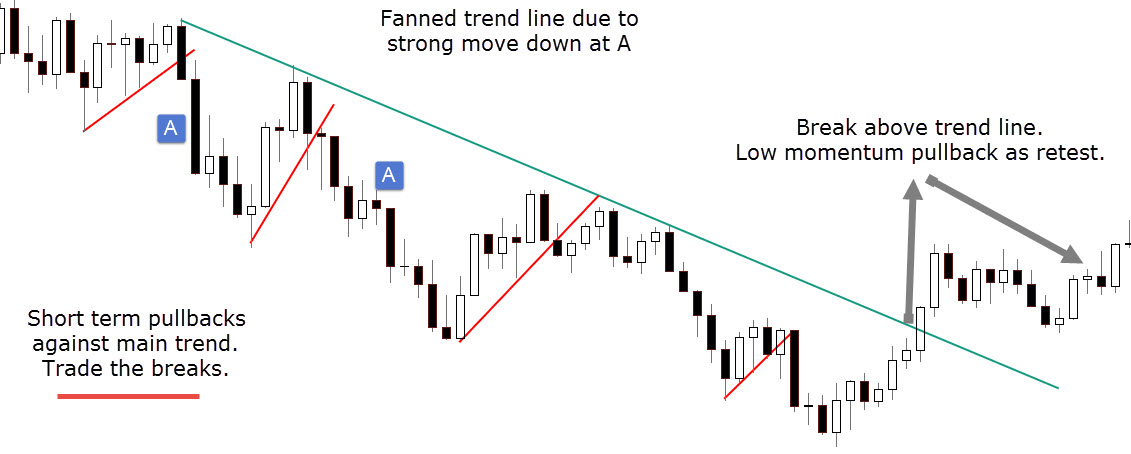Trading with trend lines as your swing trading strategy uses the rhythm of the market and price action as the core of your trading strategy.
You can not go wrong with that.
Many price action traders will use trend lines as their way of determining everything from trend to reversal points. It’s not even necessary to actually draw them when you have enough experience as you can visualize them on your charts.
How Trend Lines Work
Trend lines are one of the most basic technical analysis tools around but powerful in their usage.
First, let’s look at trend lines in terms of defining a trend.
We all know that an uptrend has price making higher highs and higher lows. When we are talking about an uptrend line, we are referring to a trend line line that uses the higher swing lows and that defines the trend.
- When price is moving up or down, it forms those higher swing highs and higher swing lows (uptrend) and lower swing highs and lowers swing lows (downtrend).
- If you draw a trendline connecting a minimum of 2 higher swing lows, you have an upward trend line. The upward trendline generally trends to provide support.
- The opposite is true when you connect a minimum of 2 lower swing highs, what you have would be a downward trendline. The downward trendline provides resistance.
This chart is using an uptrend line on a Forex chart and shows two examples of a trend line.
- The red line would be the first line you would draw. When price starts moving away and you have to cut through price, you will have to “fan” the trend line
- This is the new main trend line and you can see price bounced various times from the zones around the uptrend line.
Just because price comes close to the trend line, you will need some type of trade trigger or price action to get you into the trade.
Also know these are general rules. There are a few ways to draw your trend line and the key is consistency!
Understanding Trend Lines
It is one thing to simply draw a line on your chart but do you know why they may/may not be valid?
Every market, every Forex currency pair, they all have a rhythm to them. There will be times where price is following a general path and at other times, it will establish a different rhythm. It is this rhythm we are looking to exploit.
On this chart, you can see there are several trend lines drawn. This is due to a change in the state of the market as indicated by the arrows. At various points on this chart, the market will thrust to the upside, find a price point, consolidate, and push off again.
That is the nature of each and every market and as a technical analysis tool, the simple trend line can show you , objectively, when this occurs.
What is also common, and you can prove this to yourself, is often times pullbacks in price are similar in price between each of them.
Trading With Trend Lines
The most common method of trend line trading is using them as support or resistance and trading the reversal off of either of them.

Buying Trend Line Bounce
For Buying A Trend Line Bounce
- Draw an upward trend line connecting a minimum of 2 higher lows (or higher swing lows)
- Wait for price to come come and touch the trend line at some stage down the future
- Place a buy stop order 2-5 pips above the high of the candlestick that touches the trend line
- Place your stop loss 2-5 pips below the low of that candlestick
- Place your pofit targets on previous significant lower swing highs (or peaks) that you see on the chart.
To summarize the buy off the trend line, connect two points and wait for the third touch for the trading opportunity.
For Selling A Trend Line Bounce
- Draw a downward trendline connecting a minimum of 2 lower highs (or lower swing highs)
- Wait for price to come come and touch the trendline at some stage down the future
- Place a sell stop order 2-5 pips above the low of the candlestick that touches the trendline
- Place your stop loss 2-5 pips above the high of that candlestick
- Place your pofit targets on previous significant higher swing lows (trougs) that you see on the chart.
The selling is the exact opposite of the buying – Look to trade the third touch of the trend line.
Trading Trend Line Breaks
There are 2 ways that trend line breaks can equal a trading opportunity
- Trade a longer term trend reversal
- Trade short term trend line breaks to get on the longer term trend
Here we have a down trend and we fanned the trend line due to the strong pushes down in price.
Each time price pulls back towards the resistance trend line, we draw a support trend line on the pullback. The trade is on the break of the trend line.
On the far right of the chart, you can see the main trend line has broken. What do we do now?
We wait to see price retrace to test the former resistance trend line. Will it become support? We look for price action to tell us.
If we see a muted pullback, that is a great sign for an opposing trade.
Strong momentum in the pullback would have me standing aside until price action showed that there will be support coming into the market.
Trade Management
Trade management is a skill and probably one of the most important skills you will learn as a trader. Don’t be greedy with your profits when a trade is profitable. Learn to lock your profits by moving your stop loss and trailing it behind swing highs or swing lows that form as price moves in favor.
The reason for this is that there is less chance of you getting stopped out frequently as you are placing it behind support and resistance levels essentially.
Now, some people may decide to use profit targets while others will take more of a position trading approach with trend lines. They are trading the trend and will only exit when the trend has shown itself to be broken by a break in the trend line.
The key to long-term survival and prosperity has a lot to do with the money management techniques incorporated into the technical system. -Ed Seykota








 Posted in
Posted in